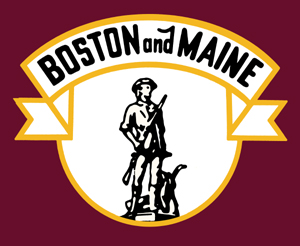
The Boston and Maine Railroad was a U.S. Class I railroad in northern New England. Originally chartered in 1835, it became part of what was the Pan Am Railways network in 1983.

North Station is a commuter rail and intercity rail terminal station in Boston, Massachusetts. It is served by four MBTA Commuter Rail lines – the Fitchburg Line, Haverhill Line, Lowell Line, and Newburyport/Rockport Line – and the Amtrak Downeaster intercity service. The concourse is located under the TD Garden arena, with the platforms extending north towards drawbridges over the Charles River. The eponymous subway station, served by the Green Line and Orange Line, is connected to the concourse with an underground passageway.

Anderson Regional Transportation Center (RTC) (noted on MBTA schedules and maps as Anderson/Woburn, and on Amtrak schedules and maps as Woburn–Anderson) is a train and bus station located at 100 Atlantic Avenue, off Commerce Way, in Woburn, Massachusetts, a suburb of Boston. It can be accessed from Exit 30 off Interstate 93 or Exit 54 (Washington Street) from southbound Interstate 95/Route 128.

The MBTA Commuter Rail system serves as the commuter rail arm of the Massachusetts Bay Transportation Authority's (MBTA's) transportation coverage of Greater Boston in the United States. Trains run over 394 mi (634 km) of track to 135 stations. It is operated under contract by Keolis, which took over operations on July 1, 2014, from the Massachusetts Bay Commuter Railroad Company (MBCR).

The Boston and Lowell Railroad was a railroad that operated in Massachusetts in the United States. It was one of the first railroads in North America and the first major one in the state. The line later operated as part of the Boston and Maine Railroad's Southern Division.
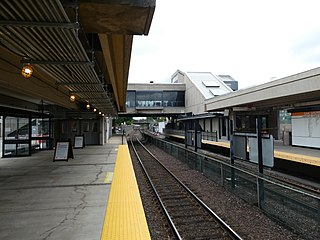
Oak Grove station is a Massachusetts Bay Transportation Authority (MBTA) intermodal transit station in the northern section of Malden, Massachusetts, just south of the Melrose border. It is the northern terminus of the rapid transit Orange Line and a stop on the Haverhill Line commuter rail service. The accessible station has a 788-space park and ride lot and is served by three MBTA bus routes.
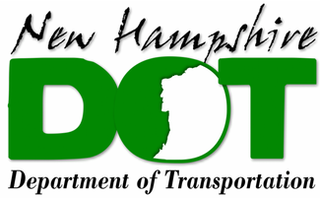
The New Hampshire Department of Transportation (NHDOT) is a government agency of the U.S. state of New Hampshire. The Commissioner of NHDOT is Victoria Sheehan. The main office of the NHDOT is located in the J. O. Morton Building in Concord.
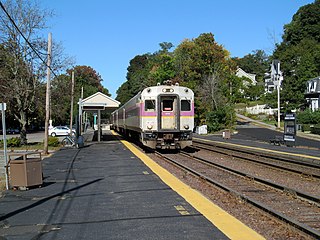
The Haverhill Line is a branch of the MBTA Commuter Rail system, running north from downtown Boston, Massachusetts to Haverhill. The service operates on the Western Route of the former Boston and Maine Railroad, which extends north to Portland, Maine, though MBTA commuter rail service has not continued north of Massachusetts since 1967.

West Medford station is an MBTA Commuter Rail station in Medford, Massachusetts. It serves the Lowell Line, and is located at West Medford Square.

Ayer station is an MBTA Commuter Rail station located off Main Street in the Ayer Main Street Historic District of Ayer, Massachusetts. It serves the Fitchburg Line. There are three tracks through the station, two of which are served by a pair of low-level side platforms, which are not accessible. There is a shelter on the inbound platform.

Reading station is an MBTA Commuter Rail station in Reading, Massachusetts. It serves the Haverhill/Reading Line. It is located at Lincoln and High Streets on the western fringe of Reading's central business district. The station's historic depot building was built in 1870 by the Boston and Maine Railroad. The station was the terminus of the line from 1959 until the re-extension to Haverhill station in 1979.
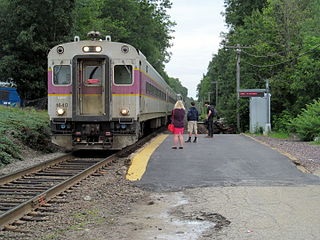
North Wilmington station is an MBTA Commuter Rail station in North Wilmington, Massachusetts. It serves the Haverhill Line, and is located off Middlesex Avenue (Route 62). It has some of the most limited station faculties on the MBTA system – a single short non-accessible platform serving the line's single track at the location, with a small parking lot and shelter for passengers. North Wilmington served by most Boston–Haverhill trains except for a small number that use the Wildcat Branch. It is a flag stop except during weekday peak hours.

The Wildcat Branch is a single track railroad branch line which connects the MBTA Lowell Line in Wilmington, Massachusetts to the MBTA Haverhill Line at Wilmington Junction. The total length of the branch line from the connection with the Lowell Line to the merge with the Haverhill Line is 2.88 miles (4.63 km). It was operated from 1836 to 1848, then rebuilt in 1874, and has been used since.
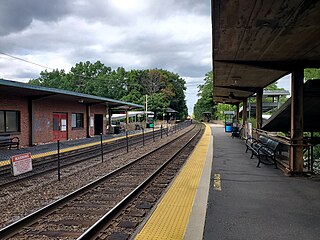
Wedgemere station is an MBTA Commuter Rail station in the southeast portion of Winchester, Massachusetts, served by the Lowell Line. The station has two side platforms serving the line's two elevated tracks. The 1957-built station building, largely unused, is adjacent to the inbound platform. After several years of work, the station was made fully accessible in February 2013.
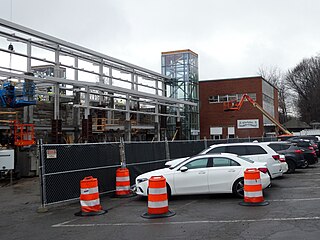
Winchester Center station is a temporarily closed MBTA Commuter Rail station in Winchester, Massachusetts, normally served by the Lowell Line. The station, located on a viaduct in downtown Winchester, was closed effective January 8, 2021 due to structural deterioration. Winchester Center station was not accessible prior to the closure, but accessible high-level platforms are being added during renovations taking place from December 2021 to December 2024. The first portion of the rebuilt station is expected to open in September 2024.

Mishawum station is an MBTA Commuter Rail Lowell Line station located in the north part of Woburn, Massachusetts just north of the Route 128/I-95 beltway. The station has two side platforms serving the line's two tracks. Mishawum is a limited-service flag stop intended for reverse commuting to the adjacent office park, with no weekend service. With just 32 boardings on an average weekday in 2018, Mishawum is one of the least busy stations on the commuter rail system.
The New Hampshire Rail Transit Authority (NHRTA) was a short lived administrative agency attached to the New Hampshire Department of Transportation (NHDOT) which was created in 2007 to oversee the development of commuter rail and other passenger rail service in New Hampshire. The agency would prove to be extraneous; constant political opposition and funding issues would hamper all NHRTA rail projects. By 2019 the group had ceased to meet, and their website URL had lapsed. Since then, the NHDOT has overseen all rail projects within the state.

Medford/Tufts station is a light rail station on the Massachusetts Bay Transportation Authority (MBTA) Green Line located off Boston Avenue near College Avenue in Medford, Massachusetts, adjacent to Tufts University. The accessible station has a single island platform serving the two tracks of the Medford Branch. It opened on December 12, 2022, as part of the Green Line Extension (GLX), which added two northern branches to the Green Line, and is the northern terminus of the E branch.
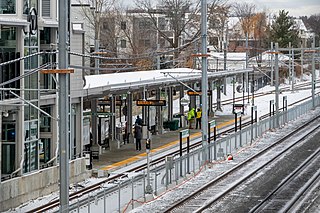
Magoun Square station is a light rail station on the Massachusetts Bay Transportation Authority (MBTA) Green Line located at Lowell Street south of Magoun Square in Somerville, Massachusetts. The accessible station has a single island platform serving the two tracks of the Medford Branch. It opened on December 12, 2022, as part of the Green Line Extension (GLX), which added two northern branches to the Green Line, and is served by the E branch.
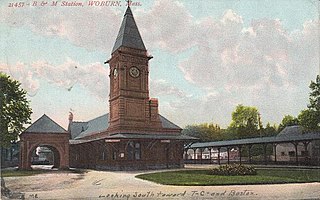
Woburn station was a railroad station on the Woburn Branch, part of the Massachusetts Bay Transportation Authority's Lowell Line.

























